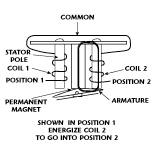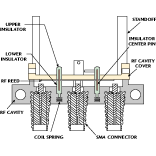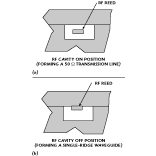An RF Power Amplifier for Whole-body MRI Scanner Applications
Communication Power Corp.
Brentwood, NY
Approximately 20 years have passed since the introduction of magnetic resonance imaging (MRI) scanners. In that time, this once-ridiculed technology has become a mainstream medical imaging modality. Coupled with MRI's anatomical imaging capability is nuclear magnetic resonance (NMR) spectroscopy, which uses the same principles as MRI but is concerned primarily with the spatial chemical composition of subjects under study. Today, a combination of these two disciplines provides physicians with the ability to spatially image and chemically analyze patients, yielding unprecedented medical diagnostic information.
A measure of an MRI scanner's power is roughly quantified by the field strength of the magnet it employs. The greater the field strength of a scanner, the proportionately better its signal-to-noise ratio (SNR). An increment in this ratio yields improved spatial resolution, translating into clearer, detailed images that can distinguish between minute parts of the anatomy. For NMR, increasing field strength provides better chemical separation/spectral resolution.
Until recently, some of the highest field strength scanners in operation were in the 3 to 4 T range. (The tesla (T) is a unit of magnetic induction equal to one weber per square meter.) The Ohio State University Advanced Biomedical Imaging center has recently completed development of a whole-body scanner operating at 8 T, a full 100 percent more powerful than any other whole-body MRI scanner in existence. This increase in field strength provides many advantages, including ultra-high resolution imaging capability down to 100 mm, a 100 percent increase in SNR, reduced imaging time resulting in increased patient throughput and a 30-fold increase in functional imaging sensitivity. This scanner is also able to resolve subanatomical structures (objects the size of capillaries).
A typical application that would benefit from high field MRI is the diagnosis and treatment of patients with epilepsy. Epileptic patients experience seizures due to depleted myelin regions adjacent to nerve fibers in the brain. The increase in imaging and spectroscopic resolution can pinpoint demyelinated regions more accurately. This increase in capability means more precisely guided neurosurgery, resulting in the elimination of seizures with minimal impairment to other brain functions.
The Output Power Assembly
An MRI scanner is an intricate machine that produces images via a complex system of superconducting magnets, receiver/transmitter antenna coils, low noise amplifiers, complex digital signal image processors and high power RF amplifiers. Fields strengths on the order of 8 T require cutting-edge power amplifier technology. An off-the-shelf communications-class amplifier cannot be expected to perform suitably in an MRI system environment.
In response to this need, an MRI-class power amplifier has been introduced that is, above all, a pulse amplifier designed to perform accurate and faithful pulse replication. All the major constituents of an input RF pulse (rise/fall time, overshoot, envelope integrity and amplitude decay) must be preserved carefully throughout the amplification process. A general list of specifications for this amplifier includes a 245 to 345 MHz frequency range, output power of 10 kW at 10 percent duty cycle, 20 ms pulse width, overshoot of less than one percent, typical rise/fall time of 300 ns with less than three percent amplitude decay and linearity of less than ±1 dB gain deviation over a 15 dB dynamic range.
Figure 1 shows the system block diagram approach used to meet these  requirements. The first two amplification stages are biased class A, primarily to satisfy the linearity requirements. The output stages are biased class AB as a trade-off between acceptable linearity and improved efficiency. Each output stage is capable of 500 W of linear power. A total of eight output stages are combined to form the output power assembly. Taking into account combiner, cable and directional coupler losses, the output power assembly is capable of at least a linear 3 kW. Each output power assembly is then combined radially to achieve a linear 10 kW.
requirements. The first two amplification stages are biased class A, primarily to satisfy the linearity requirements. The output stages are biased class AB as a trade-off between acceptable linearity and improved efficiency. Each output stage is capable of 500 W of linear power. A total of eight output stages are combined to form the output power assembly. Taking into account combiner, cable and directional coupler losses, the output power assembly is capable of at least a linear 3 kW. Each output power assembly is then combined radially to achieve a linear 10 kW.
The output power assembly is a full microprocessor-controlled unit. Each module within the unit is individually addressable via complex programmable logic devices. In the event of a device failure, the fault status is reported to the microprocessor. An alphanumeric fluorescent display on the front panel provides a full disclosure of the events occurring within the unit. In addition, the unit has a full microprocessor-controlled protection system that safeguards against input overdrive; excessive load SWR, average power, pulse width and duty cycle; and overvoltage/overtemperature. An internal sample-and-hold digital power meter continuously monitors forward and reflected power.
Typical Performance Results
 Figure 2 shows the gain variation over a dynamic range of approximately 18 dB as well as the change in insertion phase over the same dynamic range at 345 MHz and a nominal 10 kW output power. The amplifier is quite linear and exceeds the specification of ±1 dB. Figure 3 shows the phase and gain variations
Figure 2 shows the gain variation over a dynamic range of approximately 18 dB as well as the change in insertion phase over the same dynamic range at 345 MHz and a nominal 10 kW output power. The amplifier is quite linear and exceeds the specification of ±1 dB. Figure 3 shows the phase and gain variations  over the duration of a 20 ms rectangular pulse. The phase variation is outstanding at less than 1°. The amplitude decay also is impressive, showing less than 0.1 dB of decay (approximately two percent). Overshoot is well within specification as are rise and fall times of approximately 325 ns.
over the duration of a 20 ms rectangular pulse. The phase variation is outstanding at less than 1°. The amplitude decay also is impressive, showing less than 0.1 dB of decay (approximately two percent). Overshoot is well within specification as are rise and fall times of approximately 325 ns.
Conclusion
MRI technology has dramatically changed the way physicians can view inside the human body. A combination of imaging and spectroscopy holds great promise for the medical industry. The future may see in-vivo biopsies where physicians determine the malignancy of tumors electronically without ever reaching for a scalpel. Through in-vivo pharmacokinetics (an imaging technique that displays the effects of medication), the progress and effect of medications may be viewed in real time, which could aid in the analysis of cancer treatments as well as the effects of controlled substances on the human mind. This capability will invariably lead to more effective cancer treatment and a better understanding of the addictive properties of drugs. These advances will not come about following progressions made exclusively in either the engineering or medical profession, but rather as the result of a joint effort by the two industries where one assesses and determines a need and the other creates the technology to satisfy it.
Communication Power Corp.,
Brentwood, NY
(516) 434-7306.
